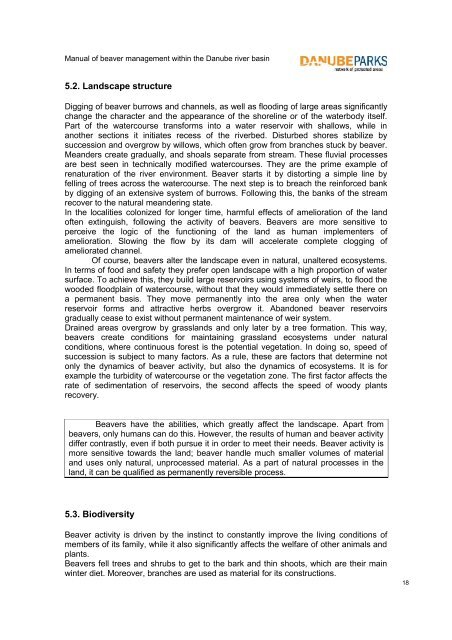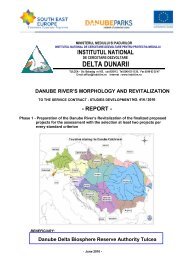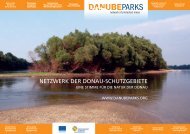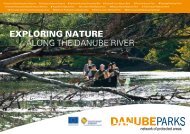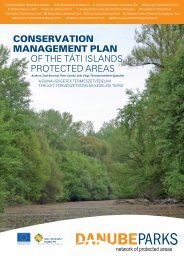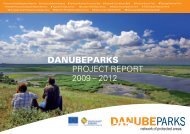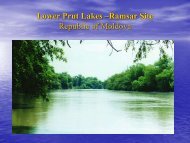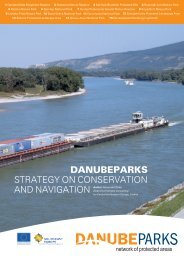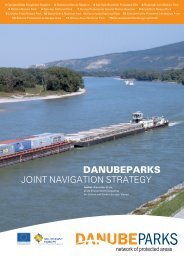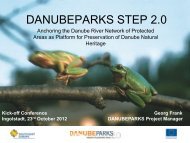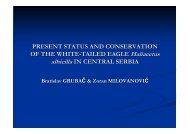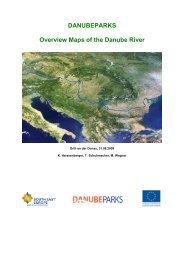Manual of beaver management within the ... - DANUBEPARKS
Manual of beaver management within the ... - DANUBEPARKS
Manual of beaver management within the ... - DANUBEPARKS
- No tags were found...
Create successful ePaper yourself
Turn your PDF publications into a flip-book with our unique Google optimized e-Paper software.
<strong>Manual</strong> <strong>of</strong> <strong>beaver</strong> <strong>management</strong> <strong>within</strong> <strong>the</strong> Danube river basin5.2. Landscape structureDigging <strong>of</strong> <strong>beaver</strong> burrows and channels, as well as flooding <strong>of</strong> large areas significantlychange <strong>the</strong> character and <strong>the</strong> appearance <strong>of</strong> <strong>the</strong> shoreline or <strong>of</strong> <strong>the</strong> waterbody itself.Part <strong>of</strong> <strong>the</strong> watercourse transforms into a water reservoir with shallows, while inano<strong>the</strong>r sections it initiates recess <strong>of</strong> <strong>the</strong> riverbed. Disturbed shores stabilize bysuccession and overgrow by willows, which <strong>of</strong>ten grow from branches stuck by <strong>beaver</strong>.Meanders create gradually, and shoals separate from stream. These fluvial processesare best seen in technically modified watercourses. They are <strong>the</strong> prime example <strong>of</strong>renaturation <strong>of</strong> <strong>the</strong> river environment. Beaver starts it by distorting a simple line byfelling <strong>of</strong> trees across <strong>the</strong> watercourse. The next step is to breach <strong>the</strong> reinforced bankby digging <strong>of</strong> an extensive system <strong>of</strong> burrows. Following this, <strong>the</strong> banks <strong>of</strong> <strong>the</strong> streamrecover to <strong>the</strong> natural meandering state.In <strong>the</strong> localities colonized for longer time, harmful effects <strong>of</strong> amelioration <strong>of</strong> <strong>the</strong> land<strong>of</strong>ten extinguish, following <strong>the</strong> activity <strong>of</strong> <strong>beaver</strong>s. Beavers are more sensitive toperceive <strong>the</strong> logic <strong>of</strong> <strong>the</strong> functioning <strong>of</strong> <strong>the</strong> land as human implementers <strong>of</strong>amelioration. Slowing <strong>the</strong> flow by its dam will accelerate complete clogging <strong>of</strong>ameliorated channel.Of course, <strong>beaver</strong>s alter <strong>the</strong> landscape even in natural, unaltered ecosystems.In terms <strong>of</strong> food and safety <strong>the</strong>y prefer open landscape with a high proportion <strong>of</strong> watersurface. To achieve this, <strong>the</strong>y build large reservoirs using systems <strong>of</strong> weirs, to flood <strong>the</strong>wooded floodplain <strong>of</strong> watercourse, without that <strong>the</strong>y would immediately settle <strong>the</strong>re ona permanent basis. They move permanently into <strong>the</strong> area only when <strong>the</strong> waterreservoir forms and attractive herbs overgrow it. Abandoned <strong>beaver</strong> reservoirsgradually cease to exist without permanent maintenance <strong>of</strong> weir system.Drained areas overgrow by grasslands and only later by a tree formation. This way,<strong>beaver</strong>s create conditions for maintaining grassland ecosystems under naturalconditions, where continuous forest is <strong>the</strong> potential vegetation. In doing so, speed <strong>of</strong>succession is subject to many factors. As a rule, <strong>the</strong>se are factors that determine notonly <strong>the</strong> dynamics <strong>of</strong> <strong>beaver</strong> activity, but also <strong>the</strong> dynamics <strong>of</strong> ecosystems. It is forexample <strong>the</strong> turbidity <strong>of</strong> watercourse or <strong>the</strong> vegetation zone. The first factor affects <strong>the</strong>rate <strong>of</strong> sedimentation <strong>of</strong> reservoirs, <strong>the</strong> second affects <strong>the</strong> speed <strong>of</strong> woody plantsrecovery.Beavers have <strong>the</strong> abilities, which greatly affect <strong>the</strong> landscape. Apart from<strong>beaver</strong>s, only humans can do this. However, <strong>the</strong> results <strong>of</strong> human and <strong>beaver</strong> activitydiffer contrastly, even if both pursue it in order to meet <strong>the</strong>ir needs. Beaver activity ismore sensitive towards <strong>the</strong> land; <strong>beaver</strong> handle much smaller volumes <strong>of</strong> materialand uses only natural, unprocessed material. As a part <strong>of</strong> natural processes in <strong>the</strong>land, it can be qualified as permanently reversible process.5.3. BiodiversityBeaver activity is driven by <strong>the</strong> instinct to constantly improve <strong>the</strong> living conditions <strong>of</strong>members <strong>of</strong> its family, while it also significantly affects <strong>the</strong> welfare <strong>of</strong> o<strong>the</strong>r animals andplants.Beavers fell trees and shrubs to get to <strong>the</strong> bark and thin shoots, which are <strong>the</strong>ir mainwinter diet. Moreover, branches are used as material for its constructions.18


